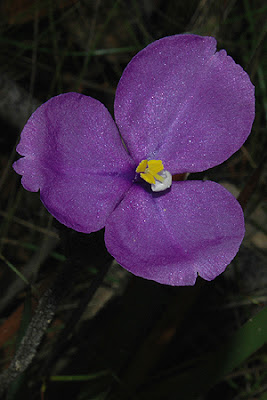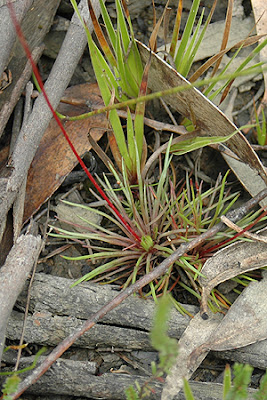However, the advantage of its location is that it is easily accessible, and it has a surprising variety of "heathland" plants. None of these plants are 'heaths", but the name comes from the type of vegetation generally occurring on these flat sandstone plateaux. In this case, because the area has been subject to much disturbance, the original "heathland" shrubbery has been removed, and the perennial plants, mostly herbaceous plants, are colonising the area.
One of the "treasures" is the Christmas Bells (Blandfordia nobilis).
 This particular plant has had one flower (at least) successfully pollinated, and you can see the seed pod forming up already. It is bright green, and is protruding from the flower tube. It is good to seed evidence of successful co-operation between the plant and insects.
This particular plant has had one flower (at least) successfully pollinated, and you can see the seed pod forming up already. It is bright green, and is protruding from the flower tube. It is good to seed evidence of successful co-operation between the plant and insects.The next flower is the "Native Iris" (Patersonia sericea). "Silky Purple Flag".
 These lovely flowers each last just a single day, but to me, that makes finding a lovely fresh specimen like this so much more precious. In fact they produce many flowers per stem, but in Robertson, they often do not open well, because they love to open on sunny mornings (and we do not always provide those). The white organ at the centre of the plant (the female part of the flower) always seems to droop over to one side. Perhaps if I go out early enough I will find one standing upright in the centre of the flower - perhaps. Most flowers illustrated on the net show something exactly the same as this specimen.
These lovely flowers each last just a single day, but to me, that makes finding a lovely fresh specimen like this so much more precious. In fact they produce many flowers per stem, but in Robertson, they often do not open well, because they love to open on sunny mornings (and we do not always provide those). The white organ at the centre of the plant (the female part of the flower) always seems to droop over to one side. Perhaps if I go out early enough I will find one standing upright in the centre of the flower - perhaps. Most flowers illustrated on the net show something exactly the same as this specimen.The next plant is the Common Fringe-lily (Thysanotus tuberosus).
This is a tiny lily, with lovely delicately fringed flowers - hence its name.
 And this next flower is as small as an old "threepenny piece" - barely 1 centimetre across. It is a perfectly formed Flannel Flower - but the "Lesser Flannel Flower" - Actinotus minor
And this next flower is as small as an old "threepenny piece" - barely 1 centimetre across. It is a perfectly formed Flannel Flower - but the "Lesser Flannel Flower" - Actinotus minorWhat I had not ever realised is that the outer "petals" (not true petals but "bracts") are very hairy, or silky, as visible in this photo.
 The centre of the flower contains numerous minute flowers arranged in an "umbel", so, effectively it is a flower containing multiple flowers. Each of the little brown dots in this flower is the central stigma of a separate flower.
The centre of the flower contains numerous minute flowers arranged in an "umbel", so, effectively it is a flower containing multiple flowers. Each of the little brown dots in this flower is the central stigma of a separate flower.It has the overall appearance of a daisy, but its internal structure is different, and it is not related to daisies at all. In fact it is closely related to the Xanthosia atkinsoniana, which I wrote about a few weeks ago. The large, and famous Flannel Flower is in fact very similar to this plant in structure, but whereas this one is smaller than a five cent coin, the regular one is the size of a twenty cent coin.
Some time ago I wrote about Trigger Plants.
 This is the small one, which grows less than 20 cm high, and has very fine, short leaves in a basal rosette. It is Stylidium lineare, whereas the other plant I wrote about was Stylidium graminifolium.
This is the small one, which grows less than 20 cm high, and has very fine, short leaves in a basal rosette. It is Stylidium lineare, whereas the other plant I wrote about was Stylidium graminifolium. Finally, this plant (Xyris juncea) is here to show a contrast with the Patersonia (above), which it resembles (superficially). It has a similar three-sided flower, but its fruit is a capsule, and it is not related to the Iris, whereas Patersonia is. The structure of the bud and fruit show this difference from the Iris tribe.
Finally, this plant (Xyris juncea) is here to show a contrast with the Patersonia (above), which it resembles (superficially). It has a similar three-sided flower, but its fruit is a capsule, and it is not related to the Iris, whereas Patersonia is. The structure of the bud and fruit show this difference from the Iris tribe. 

No comments:
Post a Comment